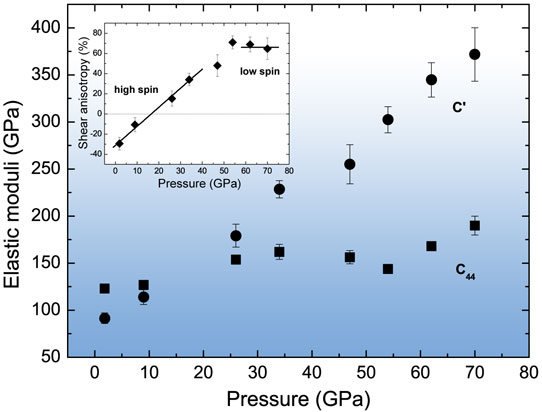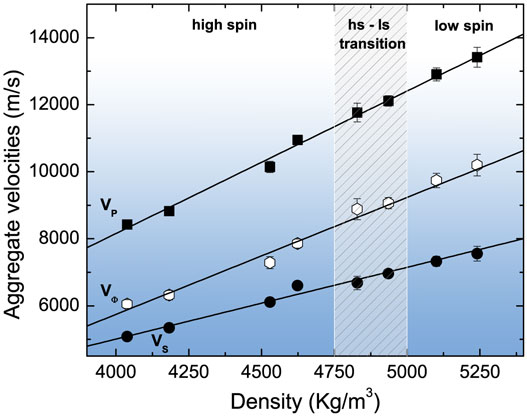- Home
- News
- Spotlight on Science
- Elasticity of ferropericlase...
Elasticity of ferropericlase across the spin crossover: A seismologically transparent transition?
21-02-2011
Large-scale structures or discontinuities in the Earth’s interior are typically caused by changes in the physical or chemical properties of minerals that occur when pressure increases with depth. In this study scientists report high-pressure measurements of the elasticity of ferropericlase by inelastic X-ray scattering. Their results indicate that the main seismic observables are not affected by the spin transition occurring in the minerals of the lower mantle.
Share
The experimental determination of the elastic properties of highly compressed minerals provides the essential link between seismic observations and geophysical models of the Earth’s interior. High-pressure measurements of the elasticity of ferropericlase (a major lower mantle mineral) show that the spin transition occurring in iron bearing minerals at lower mantle conditions does not affect the bulk and shear sound velocities of ferropericlase, but only the shear anisotropy. This suggests that although the spin transition itself does not correspond to any specific structure or anomaly in the lower mantle, it might account for the shear anisotropy observed in seismic wave propagation.
We measured the complete elastic tensor (i.e. all the independent moduli that linearly relate stress and strain) of (Mg0.83Fe0.17)O-ferropericlase across the spin transition up to 70 GPa by inelastic X-ray scattering (IXS). The IXS experiment was performed on single crystalline samples compressed in a diamond anvil cell at beamline ID28. We used the silicon (9 9 9) instrument configuration at 17.794 keV, yielding an overall energy resolution of 3 meV full-width-half-maximum. To constrain all the elements of the elastic tensor (namely C11, C12 and C44), we measured the low-q (linear) part of the phonon dispersion of selected longitudinal acoustic and transverse acoustic modes. We determined the sound velocity by a linear fit to the phonon dispersion and obtained the elastic moduli via the Christoffel equation. These data were then used to calculate the aggregate sound velocities, the aggregate elastic moduli and the shear anisotropy, conjecturing the seismological observations that may be most sensitive to the pressure-induced spin transition.
Figure 1 shows the density evolution of the aggregate compressional (VP) and shear (VS) sound velocities. In contrast with recent claims [1-3], neither VP nor VS show any distinct variation due to the spin-pairing transition. With respect to the Earth’s lower mantle, recent optical [1,3] and theoretical [2] studies proposed that an anomalous (albeit smooth) softening of the aggregate elastic properties (especially the bulk modulus K and the bulk velocity VΦ=√K/Ρ) should occur at depth. The range over which this takes place has been suggested to extend from 1000 to 1500 km, based on room-temperature results [1], and from 1300 to 1800 km, when including high-temperature effects [3], such as those along a mantle geotherm [2]. However, there is currently no seismological evidence of such elastic anomalies in this depth range [4]. Our study provides a direct explanation for the lack of a one-dimensional seismic signature associated with the spin crossover in the lower mantle.
The high-spin to low-spin transition does, however, have an effect on the single-crystal elasticity of ferropericlase. The magnitude of the shear elastic moduli C44 and C’ (corresponding to the two orthogonal polarisations of the shear mode in the diagonal plane of a cubic lattice) is shown in Figure 2 as a function of pressure. We note that at ambient and low pressures C44 > C’, but the pressure derivative of C’ is larger than that of C44, so that the two intersect around 16-17 GPa. At higher pressures the sign of shear anisotropy is reversed. Above 60 GPa, in the low spin phase, the pressure derivative of the two shear moduli is comparable. Accordingly, the pressure evolution of the shear anisotropy, defined as A=2(C’-C44)/(C’+C44), is very different for the high-spin and low-spin ferropericlase (inset, Figure 2): while A increases linearly with pressure in the high-spin phase, it remains almost constant (or slightly decreases) in the low-spin phase. Thus, we suggest that a seismically detectable signature of the spin transition in the lower mantle may be found in the seismic shear-wave anisotropy in regions of highly textured grains, corresponding to deformation due to convection.
 |
|
Figure 2. Comparison of the pressure evolution of C44 (squares) and C’ (circles). Inset: shear anisotropy as a function of pressure. The lines are guides for the eye. |
References
[1] J.C. Crowhurst, J.M. Brown, A.F. Goncharov, S.D. Jacobsen, Science 319, 451 (2008).
[2] R.M. Wentzcovitch, et al., Proc. Natl. Acad. Sci. U.S.A. 106, 8447 (2009).
[3] H.Marquardt, S. Speziale, H.J. Reichmann, D.J. Frost, F.R. Schilling, Earth Planet. Sci. Lett. 287, 349 (2009).
[4] F.Cammarano, H. Marquardt, S. Speziale, P.J. Tackley, Geophys. Res. Lett. 37, L03308 (2010).
Principal publication and authors
D. Antonangeli (a), J. Siebert (a), C.M. Aracne (b), D.L. Farber (b), A. Bosak (c), M. Hoesch (c), M. Krisch (c), F.J. Ryerson (b), G. Fiquet (a), J. Badro (a), Spin crossover in ferropericlase at high pressure: a seimologically transparent transition?, Science 331, 64 (2011).
(a) Institute de minéralogie et des physique des milieux condensés, Institut de physique du globe de Paris, Université Pierre et Marie Curie, Université Paris Diderot, Paris (France)
(b) Lawrence Livermore National Laboratory, Livermore-CA (USA)
(c) ESRF
Top image: An iron spin transition occurs in minerals at the pressure and temperature conditions of the lower mantle.




